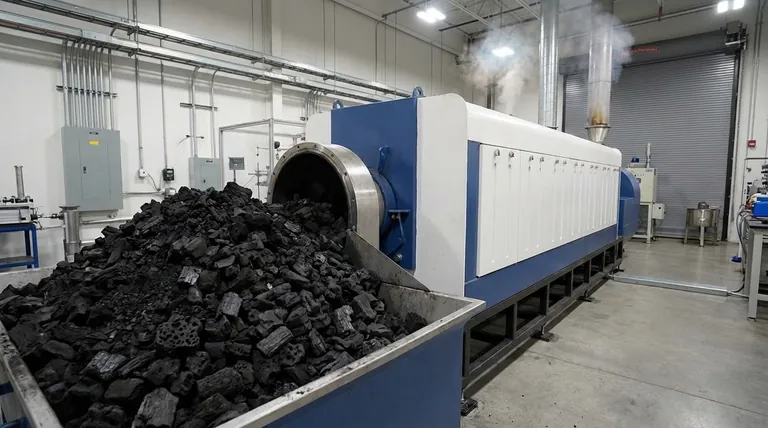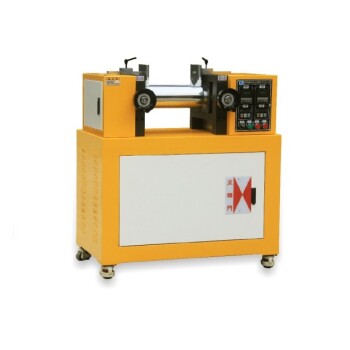The primary product of slow pyrolysis, by design, is a solid material known as biochar. While the process also yields a liquid fraction (bio-oil or wood vinegar) and a non-condensable gas (syngas), the slow heating rates and long reaction times are specifically chosen to maximize the conversion of biomass into this stable, carbon-rich solid. The other outputs are considered secondary products.
The fundamental difference between thermal conversion methods lies in their intended outcome. Slow pyrolysis is a process intentionally engineered to maximize the production of solid biochar, whereas fast pyrolysis is optimized to yield liquid bio-oil.

How Process Conditions Define the Outcome
The product distribution of any pyrolysis process is a direct result of its operating conditions. Slow pyrolysis uses a specific set of parameters to favor the creation of a solid char over liquids and gases.
The Role of Temperature and Heating Rate
Slow pyrolysis is defined by its very slow heating rates, typically between 1–30°C per minute, reaching moderate final temperatures. This process can take several hours to complete.
This slow "cooking" allows the complex polymers in biomass (like cellulose and lignin) to gradually decompose and rearrange. Volatile compounds are slowly released while the stable carbon backbone forms and solidifies into char.
Contrast with Fast Pyrolysis
In stark contrast, fast pyrolysis uses extremely high heating rates to heat biomass to a high temperature in mere seconds. This rapid thermal shock cracks the organic polymers into vapors before they can form a solid char structure. These vapors are then rapidly cooled and condensed into a liquid bio-oil.
The Oxygen-Free Environment
Crucially, all pyrolysis occurs in an oxygen-limited or completely oxygen-free environment. This prevents the biomass and its products from combusting (burning). Instead of producing ash and carbon dioxide, the thermal energy breaks the material down into new solid, liquid, and gaseous products.
A Complete View of Slow Pyrolysis Outputs
While biochar is the main goal, it is important to understand the nature and use of all three product streams. A typical slow pyrolysis process might yield up to 30% biochar by weight, with the remainder being liquids and gases.
Biochar (The Primary Solid)
Biochar is a stable, porous, and carbon-dense material similar to charcoal. Its high stability means the carbon within it is locked away and resistant to decomposition for hundreds or thousands of years.
Its primary applications are in agriculture (as a soil amendment to improve water retention and nutrient availability) and carbon sequestration.
Bio-oil (The Secondary Liquid)
The liquid fraction, sometimes called wood vinegar or pyrolysis oil, is a complex mixture of water, organic acids, alcohols, and hundreds of other compounds. It is generally acidic and requires significant upgrading to be used as a modern transportation fuel.
More commonly, it finds niche uses as a biopesticide, a natural smoke flavoring, or a source for specialty chemicals.
Syngas (The Gaseous Byproduct)
The non-condensable gas produced is called synthesis gas, or syngas. It is a mixture of combustible gases like hydrogen (H₂), carbon monoxide (CO), and methane (CH₄), along with carbon dioxide (CO₂).
In most modern pyrolysis plants, this syngas is not wasted. It is captured and burned on-site to provide the heat required to run the pyrolysis process, making the system more energy-efficient and self-sustaining.
Understanding the Trade-offs
Choosing a pyrolysis technology is entirely dependent on your desired end-product. There is no single "best" method; there is only the best method for a specific goal.
Goal: Solid vs. Liquid Product
The most significant trade-off is between solid and liquid yields. Slow pyrolysis maximizes char at the expense of oil, while fast pyrolysis maximizes oil at the expense of char.
- Slow Pyrolysis Yields: ~30% Biochar, ~30% Bio-oil, ~40% Syngas
- Fast Pyrolysis Yields: ~20% Biochar, ~60% Bio-oil, ~20% Syngas
Process Speed and Throughput
As the names imply, there is a major difference in processing time. Slow pyrolysis takes hours, which generally results in lower material throughput for a given reactor size. Fast pyrolysis is nearly instantaneous, lending itself to continuous, high-volume industrial applications.
Making the Right Choice for Your Goal
The decision to use slow pyrolysis is driven entirely by the value and intended application of its products.
- If your primary focus is carbon sequestration or agricultural soil improvement: Slow pyrolysis is the correct choice, as it is specifically optimized to produce stable, high-quality biochar.
- If your primary focus is producing a liquid biofuel or chemical feedstock: Fast pyrolysis is the superior method, as it maximizes the yield of liquid bio-oil.
- If your primary focus is converting waste to energy on-site: Either process can be effective, as both the solid biochar and the gaseous syngas are valuable fuels.
Understanding that pyrolysis is a tunable process, where conditions dictate the outcome, is the key to leveraging it effectively for your specific goal.
Summary Table:
| Product | Typical Yield (Slow Pyrolysis) | Primary Use/Condition |
|---|---|---|
| Biochar (Solid) | ~30% | Soil amendment, carbon sequestration (Slow heating rate, long residence time) |
| Bio-oil (Liquid) | ~30% | Biopesticide, chemical feedstock (Secondary product) |
| Syngas (Gas) | ~40% | On-site process heat, energy (Combustible gas byproduct) |
Ready to select the right pyrolysis technology for your biomass conversion goals?
Whether your project focuses on producing high-quality biochar for agriculture and carbon sequestration, or requires a different thermal conversion approach, KINTEK has the expertise and equipment to support you. We specialize in providing robust laboratory solutions for analyzing and optimizing pyrolysis processes.
Contact our experts today to discuss how our lab equipment can help you achieve precise and reliable results in your biomass research and development.
Visual Guide

Related Products
- Electric Rotary Kiln Small Rotary Furnace Biomass Pyrolysis Plant
- Customizable High Pressure Reactors for Advanced Scientific and Industrial Applications
- Mini SS High Pressure Autoclave Reactor for Laboratory Use
- High Pressure Laboratory Autoclave Reactor for Hydrothermal Synthesis
- Stainless High Pressure Autoclave Reactor Laboratory Pressure Reactor
People Also Ask
- What are the reactions involved in pyrolysis of biomass? Unlock the Chemistry for Tailored Bio-Products
- What are the advantages of pyrolysis technology? Turn Waste into Profit and Reduce Emissions
- Is pyrolysis viable? A Guide to Economic, Technological, and Environmental Success
- What are the components of biomass pyrolysis? A Complete Guide to the System, Products, and Process
- What are the different types of pyrolysis machines? Choose the Right System for Your Output

















